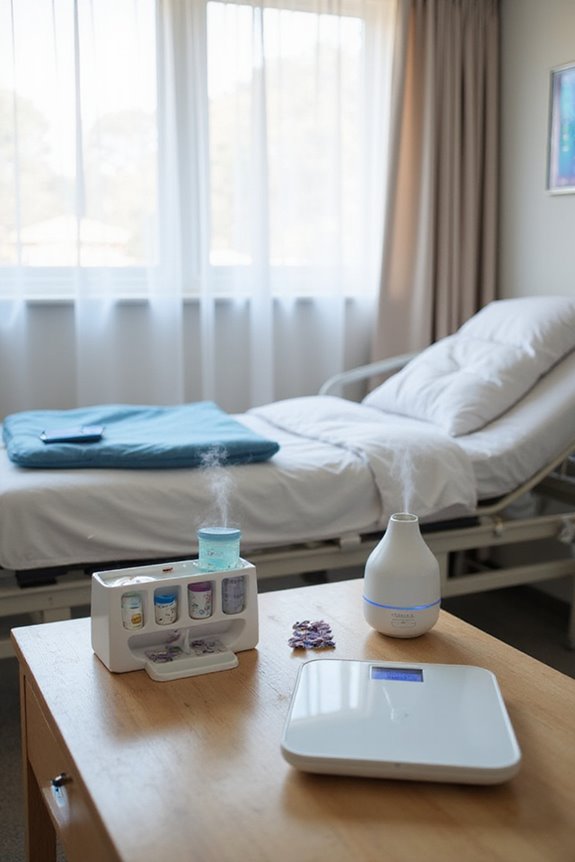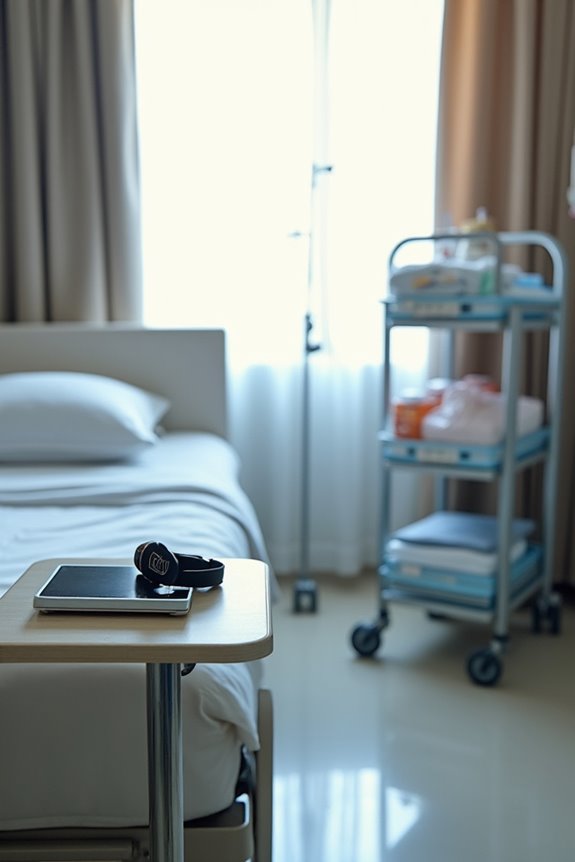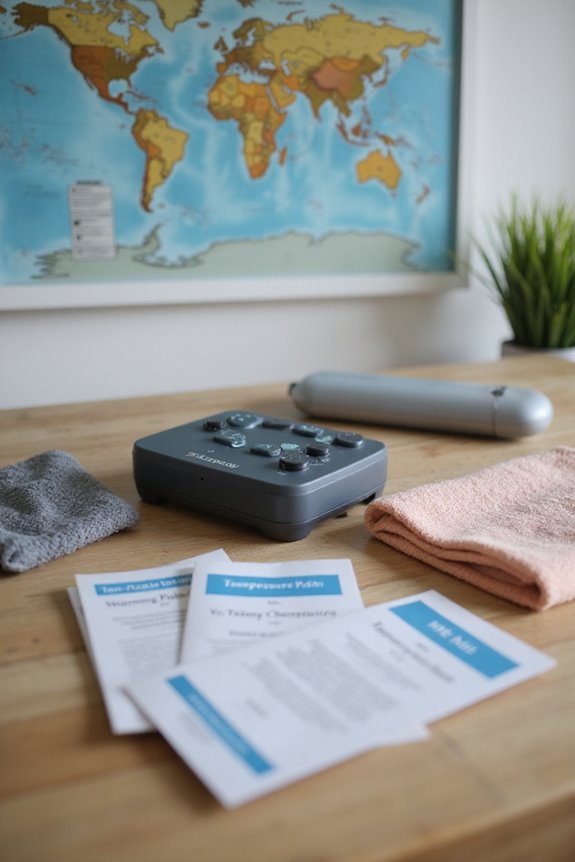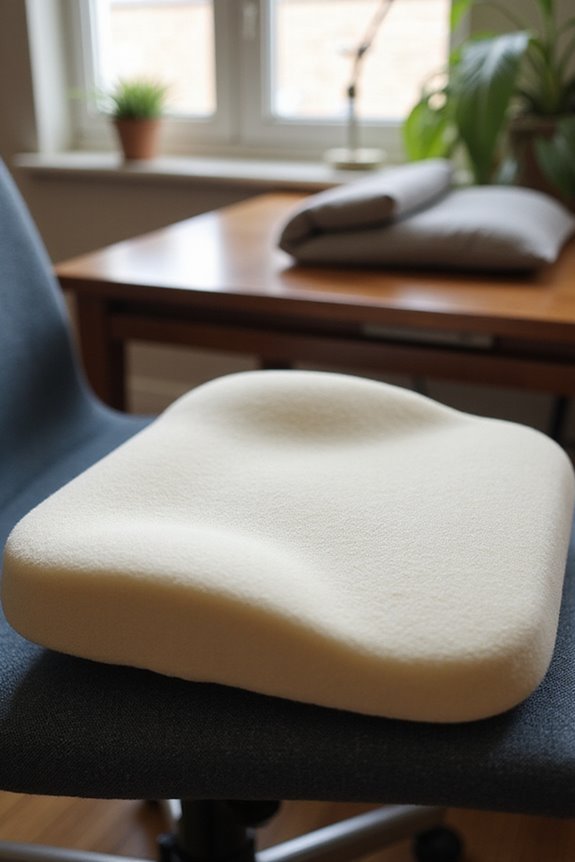Effective pain management during hospital stays requires several strategies:
- Accurate pain assessment using patient self-reporting.
- Multi-modal approaches combining medications like acetaminophen and NSAIDs to reduce opioid use by 10%-40%.
- Non-pharmacological techniques such as music therapy and mindfulness to enhance recovery.
- Engagement in care allows patients to communicate pain effectively, improving satisfaction rates.
Implementing evidence-based practices can lead to better health outcomes. Further information reveals additional methods for optimizing pain management protocols.
Key Takeaways
- Utilize a multimodal pain management approach, combining medications like acetaminophen and NSAIDs to enhance pain relief and reduce opioid use.
- Engage in non-pharmacological techniques such as music therapy and mindfulness meditation to promote relaxation and distract from pain.
- Actively participate in shared decision-making with healthcare providers to tailor pain management plans to individual needs and preferences.
- Maintain open communication with your care team to promptly report pain and adjust management strategies as needed for effective relief.
- Take advantage of psychological support and coping strategies, like cognitive behavioral therapy, to manage pain and improve overall recovery.
Understanding Pain Assessment in Hospitals
Understanding pain assessment in hospitals is imperative for effective patient management, as it directly informs treatment decisions. Thorough pain assessment tools evaluate pain intensity, location, quality, and associated symptoms.
- Patient Self-Reporting: Primary method for subjective pain experience.
- Behavioral Observation: Utilizes scales like FLACC for non-verbal patients.
- Regulatory Standards: The Joint Commission mandates standardized protocols for pain assessment and management.
- Contextual Evaluation: Clinical judgment is necessary to interpret pain types and significance.
Effective patient communication is essential for accurate assessments, ensuring that patients feel heard and understood. Scheduled reassessments after interventions allow for adjustments in management strategies, promoting better outcomes. Continuous evaluation and documentation are fundamental for maintaining accredited hospital standards.
Importance of Multi-Modal Pain Management

Multi-modal pain management represents a critical advancement in hospital pain management strategies, as it effectively addresses pain through various mechanisms.
- Benefits of Multimodal Strategies: These regimens can reduce opioid consumption by 10%-40% per day when compared to opioid-only approaches.
- Integration of Opioid Alternatives: Combining acetaminophen and nonsteroidal anti-inflammatory drugs (NSAIDs) helps decrease pain intensity and hospital readmission rates.
- Clinical Outcomes: Multimodal techniques have shown to lower postoperative opioid doses by over 20% without increasing pain scores.
- Economic Impact: Implementation of standardized multimodal protocols contributes to shorter hospital stays and fewer complications, optimizing resource utilization and reducing overall healthcare costs.
Non-Pharmacological Techniques for Pain Relief

Non-pharmacological techniques for pain relief have gained recognition as essential components in thorough pain management strategies within hospital settings. These approaches include:
- Music Therapy: Engaging with music can distract from pain signals, promoting relaxation.
- Mindfulness Meditation: Practicing mindfulness helps reduce pain sensitivity and enhances coping skills.
- Cognitive Reframing: Positive self-talk and reframing thoughts about pain can effectively alleviate discomfort.
- Physical Activity: Light exercise, such as walking, is encouraged post-surgery to improve recovery and reduce pain.
- Environmental Adjustments: Creating a calm, quiet atmosphere enhances treatment efficacy.
- Social Support: The presence of family or companions provides emotional backing, which can decrease perceived pain intensity.
Implementing these techniques can enhance overall patient satisfaction during hospital stays.
Addressing Opioid Use and Risks

Opioid use in hospital settings has become a significant concern amid rising addiction rates and associated risks.
- In 2019, 22.1% of U.S. adults with chronic pain utilized prescription opioids, contributing to the ongoing opioid epidemic.
- Metro hospitals reported an average of 30.8 opioid-related stays per 1,000 inpatient stays, compared to 16.2 in rural areas.
- Risks include addiction, respiratory depression, and increased morbidity, which strain healthcare resources.
To address these issues, hospitals are implementing opioid stewardship programs.
- These programs focus on prescription monitoring to prevent overprescribing and misuse.
- Multidisciplinary approaches, including consultation with pain specialists, optimize opioid use and improve patient outcomes.
- Standardized protocols for evaluating pain and opioid administration mitigate risks associated with opioid dependency.
The Role of Prehabilitation in Pain Management

Prehabilitation plays a pivotal role in enhancing pain management strategies for patients undergoing surgical procedures.
Prehabilitation Benefits
- Structured prehabilitation programs contribute to shorter hospital stays and fewer complications.
- Exercise protocols considerably improve muscle strength and physical fitness, potentially lowering postoperative pain intensity.
- Psychological support included in prehabilitation may reduce anxiety, influencing pain perception positively.
Research Insights
- Evidence indicates that over 500 minutes of prehabilitation can decrease acute rehabilitation admissions post hip or knee replacements (odds ratio, 0.51).
- While some studies report minor pain reduction at four weeks post total joint replacement, outcomes vary widely.
Future Considerations
– Further research is essential to clarify ideal prehabilitation dosages and components, ensuring effective pain management strategies across diverse patient populations.
Patient Self-Reporting and Its Significance
Accurate patient self-reporting is a fundamental aspect of effective pain management in hospital settings. Self-reported pain scores vary considerably, with median scores around 7/10 in some cases.
- Pain perceptions are influenced by prior experiences, attitudes, and fears, creating reporting challenges.
- Patients may over-report pain to guarantee adequate treatment, driven by anxiety about being perceived as drug-seeking.
- Numeric pain rating scales can be difficult to use, particularly when multiple pains are present.
Reliable self-reporting is crucial for personalized pain management plans. Misreporting risks under-treatment or unnecessary medication, affecting recovery and safety. Engaging patients in the reporting process fosters better communication and enhances overall pain control.
Psychological Support and Pain Management
Psychological support plays an essential role in effective pain management during hospital stays, as it addresses the multifaceted nature of pain.
- Psychological Interventions: Techniques like Cognitive Behavioral Therapy (CBT) and Acceptance and Commitment Therapy (ACT) reshape negative thought patterns and enhance psychological flexibility, aiding in pain perception.
- Coping Strategies: Group classes and individual sessions focus on developing coping skills, empowering patients to manage pain through behavioral modifications.
- Lifestyle Optimization: Support also includes strategies for improving sleep and physical activity, which can considerably impact pain severity.
- Self-Management: Patients are equipped with a toolkit of behavioral techniques, enhancing their ability to self-manage pain and improve overall well-being.
Comprehensive psychological care is crucial for reducing disability and improving quality of life during hospital stays.
Implementing Effective Hospital Policies
Implementing effective hospital policies is critical for enhancing pain management and guaranteeing patient safety. Establishing standardized hospital protocols for pain assessment is essential. These protocols should include:
- Thorough initial evaluations, considering medical and biopsychosocial factors.
- Regular reassessment intervals to monitor changes in pain levels.
- Documentation of pain diagnoses in patient records for seamless communication.
Multidisciplinary collaboration improves outcomes. Engaging a team of physicians, nurses, and pharmacists guarantees holistic pain management. Continuous staff education on best practices, including alternative therapies, can reduce opioid reliance. Furthermore, evidence-based guidelines should inform treatment decisions. Incorporating risk assessments for opioid prescribing enhances patient safety. Policies must prioritize patient-centered approaches, fostering collaboration between patients and care teams in pain management planning, optimizing comfort and recovery. In addition, utilizing topical pain relief gels can provide immediate localized relief for patients experiencing acute pain during their hospital stay.
Continuous Quality Improvement in Pain Management
Continuous quality improvement in pain management is crucial for enhancing patient outcomes within hospital settings. Implementing effective interdisciplinary collaboration is key. This involves:
- Engaging nursing, physicians, and specialty providers to create patient-centered pain management plans.
- Utilizing standardized pain assessment tools within electronic medical records to guarantee accurate and timely documentation.
- Monitoring quality metrics, such as HCAHPS pain management scores, to evaluate patient satisfaction and outcomes.
Routine communication protocols among teams facilitate coordinated pain assessment and management strategies. Additionally, ongoing staff education and empowerment can greatly enhance pain management practices. By promoting a culture of continuous improvement, hospitals can address gaps in care, guaranteeing that pain management strategies align with evidence-based guidelines while meeting individual patient needs. Incorporating safety features in pain management tools, such as automatic shut-off on heating pads, can further ensure patient comfort and well-being during their stay.
Engaging Patients in Their Pain Management Plan
Engaging patients in their pain management plan is a pivotal aspect of enhancing healthcare outcomes. Patient involvement greatly correlates with improved satisfaction and pain control.
Key strategies include:
- Shared Decision Making: Collaborating with patients to tailor pain management plans enhances relevance and effectiveness.
- Continuous Dialogue: Ongoing communication fosters trust and encourages timely pain reporting.
- Real-Time Monitoring: Utilizing data dashboards allows for prompt adjustments based on patient feedback.
Benefits of engagement encompass:
- Reduced severity of pain episodes during hospital stays.
- Increased patient satisfaction rates, reaching up to 94.1% in specific demographics.
- Empowered patients are more likely to communicate pain effectively, enabling quicker interventions.
Frequently Asked Questions
What Should I Do if My Pain Isn’t Managed Effectively?
In the garden of healing, if thorns of pain persist, one must summon the courage to communicate openly. Employ advocacy strategies to express needs, ensuring that the path to relief is clear and understood.
Can I Request Alternative Pain Management Options During My Stay?
Patients can indeed request alternative therapies during their stay, embracing holistic approaches to pain management. Engaging in open communication with healthcare providers fosters a collaborative environment, ensuring tailored care that aligns with individual preferences and needs.
How Can Family Members Support Pain Management in the Hospital?
Family members can enhance pain management through effective communication strategies and emotional support. By understanding the patient’s needs, advocating for proper treatment, and providing reassurance, they foster a supportive environment that positively impacts the patient’s recovery experience.
What Are the Side Effects of Common Pain Medications?
Common pain medications exhibit various side effects. Opioid side effects include sedation and constipation, while non-opioid alternatives like NSAIDs can cause gastrointestinal issues. Understanding these effects helps individuals make informed choices about pain management options.
How Is My Pain Management Plan Adjusted During My Hospital Stay?
“Where there’s a will, there’s a way.” Pain management plans adjust through ongoing pain assessments and medication adjustments, ensuring that individual needs are met effectively, fostering a sense of belonging and shared decision-making among patients and providers.





